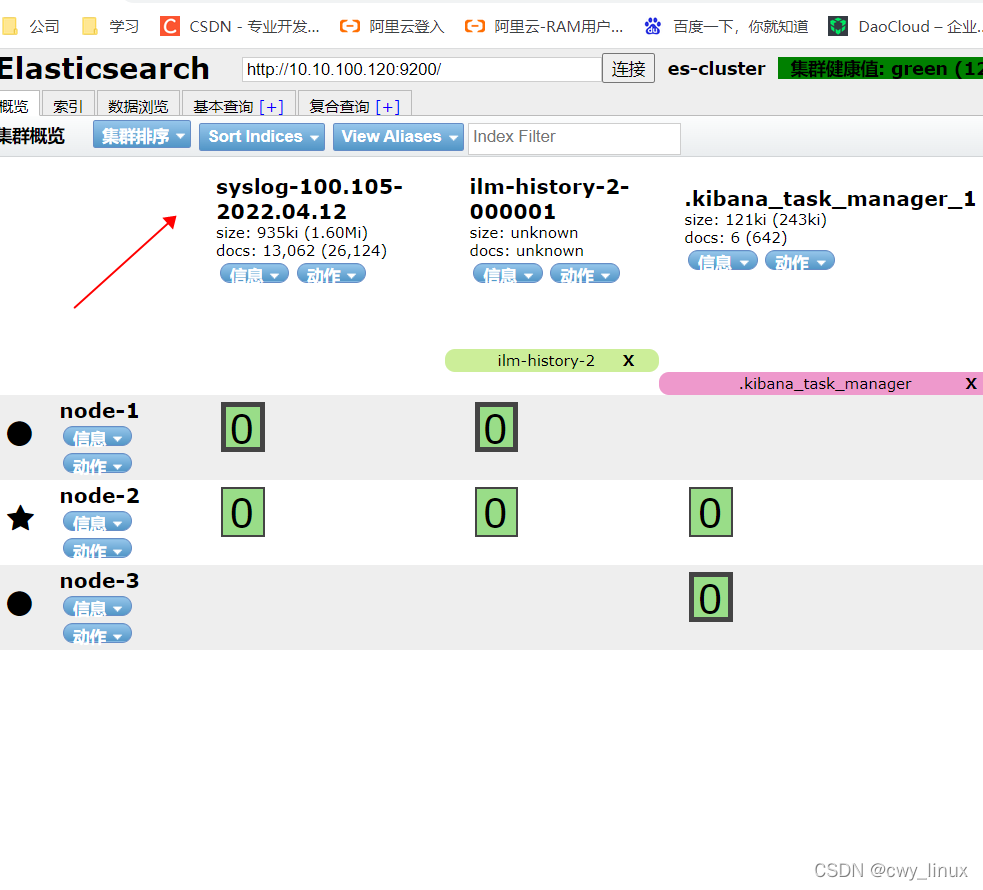logstash 日志收集
1、logstash 收集系统日志logstash配置文件root@logstash-node1:~# vim /etc/logstash/conf.d/syslog-to-es.confinput {file {path =>"/var/log/syslog"#第一次从头收集,之后从新添加的日志收集start_position => "beginning"#日志收集的间隔时间stat
·
1、logstash 收集系统日志
1.1 logstash配置文件
root@logstash-node1:~# vim /etc/logstash/conf.d/syslog-to-es.conf
input {
file {
path =>"/var/log/syslog"
#第一次从头收集,之后从新添加的日志收集
start_position => "beginning"
#日志收集的间隔时间
stat_interval =>"3"
type=>"syslog"
}
}
output {
if [type] == "syslog" {
elasticsearch {
hosts => ["10.10.100.120:9200"]
index => "syslog-100.105-%{+YYYY.MM.dd}"
}
}
}
1.2 启动logstash
#添加syslog文件读权限,或者直接使用root用户启动logstash
root@logstash-node1:~# chmod o+r /var/log/syslog
#启动前可以通过命令测试配置文件
root@logstash-node1:~# /usr/share/logstash/bin/logstash -f /etc/logstash/conf.d/syslog-to-es.conf -t
#测试正常后重启logstash
root@logstash-node1:~# systemctl restart logstash
1.3 查看es索引
root@es-node1:~# curl 'localhost:9200/_cat/indices?v'
health status index uuid pri rep docs.count docs.deleted store.size
green open syslog-100.105-2022.04.12 2sKdW70BSz2ob8Jfxb6jXw 1 1 13062 0 4.8mb 2.4mb

1.4 kibana 查看日志
1.4.1 创建索引模式
Stack Management >> 索引模式 >> 创建索引模式




1.4.2 查看日志
Discover


2、tomcat日志收集
2.1 tomcat 日志转 json
root@logstash-node1:/apps/tomcat# vim conf/server.xml
<Valve className="org.apache.catalina.valves.AccessLogValve" directory="logs"
prefix="localhost_access_log" suffix=".log"
pattern="{"clientip":"%h","ClientUser":"%l","authenticated":"%u","AccessTime":"%t","method":"%r","status":"%s","SendBytes":"%b","Query?string":"%q","partner":"%{Referer}i","AgentVersion":"%{User-Agent}i"}"/>
#验证查看日志
root@logstash-node1:/apps/tomcat# tail -f logs/localhost_access_log.2022-04-13.log
{"clientip":"10.10.100.1","ClientUser":"-","authenticated":"-","AccessTime":"[13/Apr/2022:11:32:18 +0800]","method":"GET / HTTP/1.1","status":"200","SendBytes":"14","Query?string":"","partner":"-","AgentVersion":"Mozilla/5.0 (Windows NT 10.0; Win64; x64) AppleWebKit/537.36 (KHTML, like Gecko) Chrome/100.0.4896.75 Safari/537.36"}
{"clientip":"10.10.100.1","ClientUser":"-","authenticated":"-","AccessTime":"[13/Apr/2022:11:32:18 +0800]","method":"GET /favicon.ico HTTP/1.1","status":"200","SendBytes":"21630","Query?string":"","partner":"http://10.10.100.115:8080/","AgentVersion":"Mozilla/5.0 (Windows NT 10.0; Win64; x64) AppleWebKit/537.36 (KHTML, like Gecko) Chrome/100.0.4896.75 Safari/537.36"}
2.2 配置logstash
root@logstash-node1:~# vim /etc/logstash/conf.d/tomcat_access_log.conf
input {
file {
path => "/apps/tomcat/logs/localhost_access_log.2022-04-13.log"
start_position => "beginning"
stat_interval =>"3"
type=>"tomcat_access_log"
codec => "json"
}
}
output {
if [type] == "tomcat_access_log" {
elasticsearch {
hosts => ["10.10.100.120:9200"]
index => "tomcat-accesslog-100.105-%{+YYYY.MM.dd}"
}
}
}
#添加日志文件权限
root@logstash-node1:~# chmod o+r /apps/tomcat/logs/localhost_access_log.2022-04-13.log
#重启logstash
root@logstash-node1:~# systemctl restart logstash
2.3 验证查看
查看索引
root@es-node1:~# curl '10.10.100.120:9200/_cat/indices?v'
health status index uuid pri rep docs.count docs.deleted store.size pri.store.size
green open tomcat-accesslog-100.105-2022.04.13 nXmwge_JQo6oTDx5BZK_3g 1 1 23 0 124.9kb 73.3kb
green open syslog-100.105-2022.04.13 8sm8Asb1RSyZZQvVSvsjhw 1 1 42 0 90.8kb 57.9kb
kibana查看日志

3、nginx日志收集
3.1 配置nginx json格式日志
root@logstash-node1:/apps/nginx# vim conf/nginx.conf
log_format access_json '{"@timestamp":"$time_iso8601",'
'"host":"$server_addr",'
'"clientip":"$remote_addr",'
'"size":$body_bytes_sent,'
'"responsetime":$request_time,'
'"upstreamtime":"$upstream_response_time",'
'"upstreamhost":"$upstream_addr",'
'"http_host":"$host",'
'"url":"$uri",'
'"domain":"$host",'
'"xff":"$http_x_forwarded_for",'
'"referer":"$http_referer",'
'"status":"$status"}';
access_log /apps/nginx/logs/access.log access_json;
#添加权限
root@logstash-node1:/apps/nginx# chmod o+r /apps/nginx/logs/access.log
3.2 配置logstash
root@logstash-node1:~# vim /etc/logstash/conf.d/nginx-access.log
input {
file {
path => "/apps/nginx/logs/access.log"
start_position => "beginning"
stat_interval => "3"
type => "nginx-access-log"
codec => json
}
}
output {
if [type] == "nginx-access-log" {
elasticsearch {
hosts => ["10.10.100.120:9200"]
index => "nginx-accesslog-100.105-%{+YYYY.MM.dd}"
}
}
}
#重启logstash
root@logstash-node1:~# systemctl restart logstash
3.3 验证查看

4、java 日志搜集
使用 codec 的 multiline 插件实现多行匹配,这是一个可以将多行进行合并的插件,而且可以使用 what 指定将匹配到的行与前面的行合并还是和后面的行合并,
https://www.elastic.co/guide/en/logstash/current/plugins-codecs-multiline.html
4.1 配置logstash
root@logstash-node1:~# vim /etc/logstash/conf.d/java_log.conf
input {
file {
path = "/tmp/java.log"
type = "java-log"
start_position => "beginning"
stat_interval => "3"
codec => multiline {
#匹配年月日开头行时进行多行合并
pattern => "^([0-9]{4}-[0-9]{2}-[0-9]{2}"
#true 为匹配成功进行操作,false 为不成功进行操作
negate => true
#与之前的行合并,如果是下面的行合并就是 next
what =>"previous"
}
}
}
output {
if [type] == "syslog" {
elasticsearch {
hosts => ["10.10.100.120:9200"]
index => "javalog-100.105-%{+YYYY.MM.dd}"
}
}
}
4.2 kibana 查看日志

更多推荐
 已为社区贡献3条内容
已为社区贡献3条内容









所有评论(0)